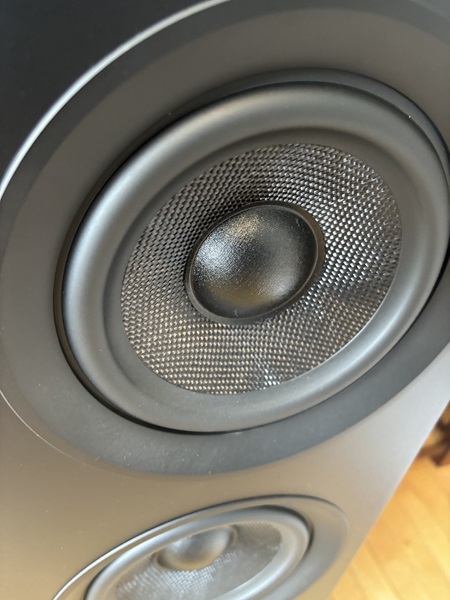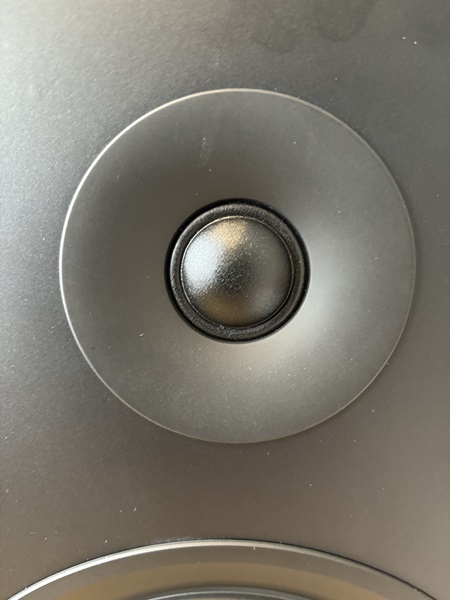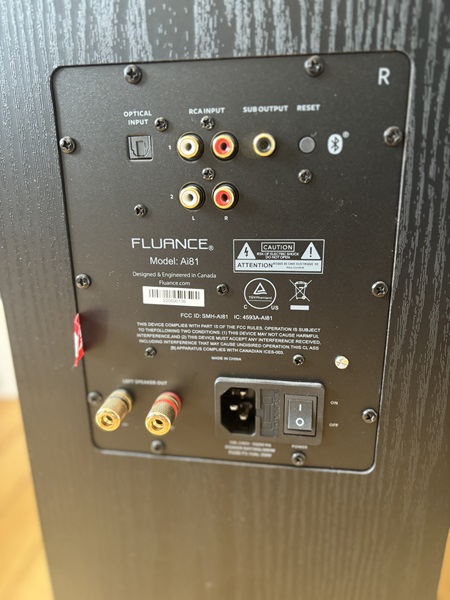Fluance Ai81 Elite Powered Tower Speakers – Big Sound and Big Value!
Not everyone has the space for an AV receiver and speaker setup. We’ve addressed how you can get away with a simpler setup in several articles. One of the easiest ways is to get a pair of powered speakers. We’ve reviewed the Fluance Ai41 powered speakers in the past. At $250, we dubbed them “Soundbar Killers.” The Ai81 Elite offering is twice the price but they are over twice the size! These speakers would be great for those who don’t want stands or don’t have any more real estate on their furniture for bookshelf speakers. Are they a viable solution for your AV needs? Priced at $500, they are certainly priced right for those looking for an option other than a soundbar. Are the Fluance Ai81 Elite powered tower speakers as big a value as the great-sounding Ai41’s? Let’s discuss.
Fluance Ai81 Elite Powered Tower Speakers Specs
| Speaker Type | Floorstanding |
|---|---|
| Speaker Configuration | 2 Way – 3 Driver Powered Floorstanding Speaker System with Integrated Amplifier (Pair – 1x Active 1x Passive) |
| Enclosure | Tuned Down-Firing Port Bass Reflex Design Dampened |
| Tweeter | 1 inch Silk Soft Dome Neodymium Ferrofluid Cooled |
| Woofer | Dual 6.5 inch Woven, Glass Fiber Composite Drivers with Butyl Rubber Surrounds |
| Amplifier Power | Class D 150 Watts Continuous Average Output (2x 75 Watts RMS) |
| Frequency Response | 30Hz-20kHz (DSP Enhanced) |
| Crossover Frequency | 2200Hz Phase Coherent 12dB/Oct – PCB Mounted Circuitry |
| Bluetooth | Yes; Bluetooth 5.0 |
| Audio Inputs | 2x RCA L/R, Bluetooth, & Digital Optical TOSLINK |
| Internal Lead Wire | 18 gauge Internal Lead Wire to Reduce Signal Degradation |
| Subwoofer Output | Yes, 80 Hz Low-pass Frequency Cutoff |
In The Box
The Fluance Ai81 Elite powered speakers have everything they need right in the box. One speaker per box, a remote (with batteries), a power cord, a quick start guide, and a speaker wire to connect the pair. Everything was packaged securely, and despite UPS’s best effort to damage these speakers, they were in pristine condition.
First Impressions Of The Fluance Ai81
I like tower speakers. They look great, have a distinct cachet, and can be easier to place in certain situations. The Fluance Ai81 Elite is an aesthetically pleasing set of down-ported tower speakers in an attractive black ash finish. If black is not your jam, Fluance offers them in bamboo, natural walnut, and white walnut. However, there is no front grill with the speakers available. The down-firing power on the bottom of the speaker is a nice touch as it gives you the benefit of the extra bass without limiting placement as much as a rear-ported speaker.

The Fluance Ai81s sport a pair of 6.5″ woven fiberglass woofers paired with a 1″ silk neodymium dome tweeter. I consider them mid-sized tower speakers, measuring 37.8″ high, 8.5″ wide, 10.24″ deep, and about 30 lbs per speaker. A 150w (2x75w) class D amplifier powers the pair, and Fluance rates them from 30Hz to 20kHz (DSP enhanced).


The input selection impressed me for a $500 powered speaker. You get a pair of RCA inputs, an optical input, Bluetooth, and a subwoofer input! You read that correctly. There is a dedicated subwoofer output to pair small (or large) subwoofers with your Fluance Ai81 Elite powered speakers.
Setting Up The Fluance Ai81 Elite
Setting the Fluance Ai81 Elite active tower speakers was a snap. Get them into their spot, connect the power cord and speaker wire, and plug your source into them via the RCA or optical inputs or pair via Bluetooth.
Using the inputs or Bluetooth is a snap. The back of the right speaker has a circular control knob. If you roll the knob, you control the volume. If you press on the knob, it cycles through the inputs. Having a physical option to control the speakers without needing the remote is nice. Fluance placed an LED on the front of the speaker that changes colors based on your input. You can also use the remote to control these functions.

Bluetooth pairing is started by pushing the pairing button on the back of the speaker and looking for the Fluance Ai81ai81 tower speakers in your phone’s Bluetooth. I had them up and streaming music in less than 30 seconds. Using the other inputs was just as simple. Connect your source, select the correct input, and press play!
Listening To The Fluance Ai81 Active Speakers
I am going to be upfront and let you know that, overall, I like the sound of the Fluance Ai81 active speakers. For $500, the sound quality of the Fluance Ai81 Elite Powered Tower speakers represents a great value. Many speaker manufacturers design their speakers with a sound signature in mind. Fluance uses a slight “smiley face” curve with the Ai81, more pronounced bass, and treble, with the mids flatter. Given these presumed target customers, I think that’s a perfect EQ. They boost bass and treble, emphasizing dialogue more, which is excellent for a 2.0 or 2.1 setup. More on that later.
Music
Music is a mixed bag for me. I listen to a wide variety of music. My playlist could start with vocal jazz and end with classical music, with hip-hop, rock, and acoustic stuff mixed in. Here is where the smiley face curve showed. With vocal jazz and classical music, the Fluance Ai81 sounded great. They were crisp, and everything sounded detailed. But with some of my hip-hop albums, the mids sounded a bit flat and muddled with the bass.
As I approached higher volumes, there was some noticeable woofer breakup that was attenuated by lowering the volume and adding a subwoofer. But let’s be real here. I have these speakers in my 13’x21′ home theater, with seven large sound absorbers. In this room, I need to push them to higher volumes to overcome the room’s acoustics. In a typical living room, you wouldn’t need to turn them up as high, negating the woofer break-up entirely.

While Fluance rates them down to 30Hz, I realistically know a tower speaker with a pair of 6.5″ woofers can’t dig that deep. So what did I do? I hooked up my SVS PB-1000 Pro to them. The Fluance Ai81 active speakers have an internal low pass filter of 80Hz, so it was plug-and-play!
The muddled bass cleared up significantly by relieving the Fluance Ai81 of bass duty, revealing better mids. I also repositioned the speakers by my room treatment panels and noticed a massive difference in my treated room. Remember, kids…acoustically treat your rooms!
Stereo imaging is excellent on the Fluance Ai81 powered speakers. The speakers have a generous sweet spot, and I ended up not toeing them in at all. And because they are downward ported, Speaker Boundary Interference Response (SBIR) is not a huge issue. I played with placement, putting them closer and further away from walls, and found that about 12-18″ away from the wall is perfect.
TV
Clearly the Fluance Ai81s Elite tower speakers are designed to compete with soundbars. They are targeted at consumers who are looking for better sound at soundbar prices. With the boosted treble, it’s great for dialogue. Plus, the excellent stereo separation makes for a great 2.0 or 2.1 system. I used them with my TV to watch a movie, and I was very pleased with the fullness of the soundstage. Yes, I added the subwoofer to the mix, but I added two with my regular setup.
The dialogue was crisp and easy to hear. I didn’t find myself straining to hear anything, and I could easily pick up lower dialogue. But don’t expect to hit reference volume with these speakers in very large rooms. In smaller rooms, they should be fine. But in a setup with limited space and my option is a soundbar or the Fluance Ai81s, my choice is clear.
EQ
As mentioned in the specs, the Ai81 Elite tower speakers have integrated DSP. What was most helpful was the built-in tone controls for bass and treble. I could knock down the treble to where it sounded perfect to my ears. The same goes for the bass. While I appreciate the sound that Fluance targets, I like the ability to tailor it to my preferences.

Our Take

If you are looking for a great-sounding non-soundbar option, the Fluance Ai81 Elite Powered Tower Speakers are a great value. That’s a resounding yes. While these speakers aren’t perfect, for $500 they are a darn good deal. Plus, with a good sub, and the ability to adjust the tone settings of your speakers, you can tailor them to suit most preferences.
Verdict: AV Gadgets Approved!


